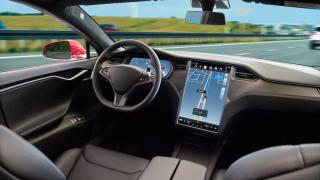
Now more than ever before, innovation is at the forefront of the engineering landscape, as the industry turns ideas that were once thought to be futuristic into reality. The rise of 'smart' technology has expanded this reach beyond what was ever thought possible, simplifying everyday tasks and creating limitless possibilities. Vertical sectors are seeing huge development in their respective fields as they work to make solutions greener, smarter and less reliant on manual input.
Though yet to grace our roads, autonomous vehicles have long been on the radar as a potential new area of development. With the use of road vehicles now higher than ever - largely due to their accessibility, as well as the exponential growth of online shopping - the time is nigh for autonomous vehicles to strike out and make their mark.
The Feasibility of Self-Driving Cars:
The building blocks of such technologies are already widely used in modern cars.
When we think of autonomous vehicles, likely the first thing that comes to mind is the notion of a self-driving car, which requires little to no involvement from the driver to get from point A to point B. Self-driving cars are aware of their surroundings and can respond accordingly, negotiating physical obstacles and following an appropriate path of navigation to reach their destination.
These concepts may sound far-fetched, but modern cars already feature low-scale versions of these features in the form of driver-assist functions. Emergency braking, parking assistance and lane control all require a level of awareness from the vehicle itself, meaning that a driverless vehicle is simply the next logical step in vehicle evolution. That's not to say that self-driving vehicles are on the verge of becoming mainstream, but the building blocks of such technologies are already widely used in modern cars.
There are a number of safety concerns surrounding the concept of a self-driving car.
Projects to develop and implement self-driving cars are already very much underway, with automotive heavyweights such as Tesla and Nissan in the process of developing such a vehicle. However, there are a number of safety concerns surrounding the concept of a self-driving car that would need to be fully resolved before they could be let loose on our roads. During a 2018 test of a self-driving car by Uber, a pedestrian was mown down and killed as she crossed the road; meanwhile, a driver for Tesla was killed in 2016 whilst testing its autopilot system.
These examples of fatal injury within the testing phase illustrate the need for ongoing development of the driverless car concept on a much wider scale before such technology is committed to everyday use. However, self-driving cars are not the only example of autonomous vehicles, nor are they likely to be the first to reach widespread adoption.
READ: Homes of the Future Could Be Powered By 'Smart' Bricks
Pizza, Groceries & More:
Food delivery apps have become an intrinsic feature of everyday life, resulting in more cars on the roads.
A much more feasible widespread use of autonomous vehicles in the near future is within the realms of food delivery. Food delivery apps, as well as home deliveries of groceries, have become an intrinsic feature of everyday life, resulting in more cars on the roads and a greater impact on the environment. Whilst home delivery is here to stay, it is essential that measures are taken to reduce the ensuing emissions, which is where autonomous vehicles come into play.
The development of autonomous delivery vehicles has advanced much further than that of the self-driving car, owing largely to the reduced number of safety implications. Whilst road vehicles travel at greater speeds, leaving minimal error margins, autonomous delivery vehicles are being developed that typically travel at speeds of less than 5 miles per hour. This means that any accidents are likely to have much less severe consequences than those at higher speeds. Moreover, such vehicles are designed for use on pavements instead of roads and are programmed to travel in consideration with pedestrians, even giving them right of way.
These factors make autonomous delivery vehicles a favoured starting point for such technology and are already in use on a trial basis. As these vehicles run on electricity, there are less resulting emissions, lessening environmental harm and reducing the number of vehicles on the roads.
READ: Is Hydrogen the Answer To Zero-Emissions Air Travel?
Autonomous Vehicles of the Future:
The simultaneous use of a variety of autonomous transportation mediums could drastically reduce the number of road-based vehicles.
There are plenty of benefits that come hand-in-hand with the dawn of autonomous vehicles. As well as reducing emissions, autonomous vehicles could ultimately ease the growing congestion on our roads, slash the associated costs of transportation and cut travel times. It's easy to see why autonomous vehicles have been earmarked for development, although the associated concerns surrounding safety may prevent full adoption for quite some time.
However, that's not to say that autonomous vehicles are limited to road or pavement use; instead, a number of different applications are in progress that address the issues of longer-distance freight travel. Magway - a UK-based company - are developing a system for the transportation of goods via a series of underground pipes. Meanwhile, autonomous drones are also being explored in order to provide aerial deliveries. The simultaneous use of a variety of autonomous transportation mediums could drastically reduce the number of road-based vehicles in use and deliver more efficient results, boosting the economy and allowing for faster travel.
With a plethora of exciting new trials taking place within the field of vehicle autonomy, we are bound to see an increase in use over the coming years and decades. However, the resulting short-term adoption of autonomous vehicles may have less to do with the futuristic image of self-driving cars and instead, are more aligned to providing efficient delivery and freight solutions on both a short and long-distance basis.
